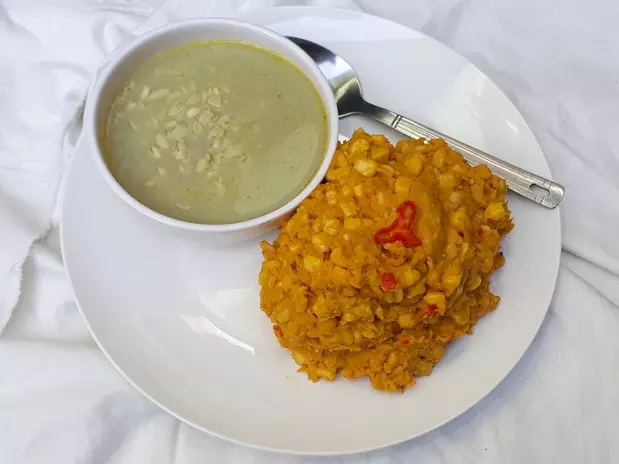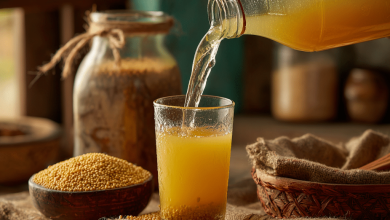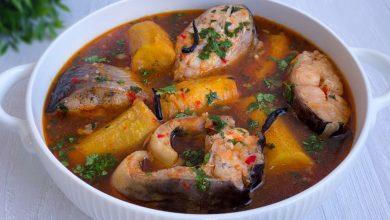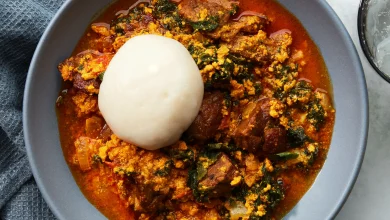Introduction
Ukwa, a cherished delicacy from the southeastern regions of Nigeria, exemplifies the rich culinary traditions of Nigerian cuisine. At its core, Ukwa is a hearty, flavorful dish that celebrates breadfruit—an often underappreciated fruit that holds cultural and nutritional significance in Nigerian communities. This dish is more than just a meal; it is a symbol of communal harmony, indigenous ingredients, and culinary artistry passed down through generations.
Native to the tropical regions, breadfruit is a versatile and nourishing ingredient, often used as a starchy substitute for potatoes or yams. When cooked in the Nigerian style, particularly in the form of Ukwa, it absorbs bold flavors from palm oil, spices, and herbs, resulting in a rich, aromatic, and satisfying dish. The preparation process involves meticulous selection of ingredients, careful seasoning, and slow simmering to develop complex flavors and tender textures that define authentic Nigerian cooking.
This detailed guide aims to provide a comprehensive, step-by-step approach to preparing Ukwa, ensuring that even novice cooks can master this beloved dish. From ingredient sourcing to presentation, every aspect is covered to help you recreate this traditional Nigerian recipe authentically. As a proud feature on Love With Recipes, this recipe emphasizes cultural authenticity, nutritional value, and culinary excellence, making it a perfect addition to your culinary repertoire.
Time
Preparation Time: Approximately 30 minutes
Cooking Time: 40-45 minutes
Total Time: About 1 hour 15 minutes
Needed Equipment
- Large stainless steel or cast iron pot with lid
- Sharp vegetable peeler or paring knife
- Cutting board
- Measuring spoons and cups
- Stirring spoon or spatula
- Fine mesh strainer or colander
- Kitchen tongs or slotted spoon
- Serving bowls or plates
- Optional: Blender or masher for thickening
Tags
Nigerian cuisine, traditional dish, breadfruit, hearty meal, African recipes, palm oil dishes, gluten-free, plant-based, family-friendly, cultural cuisine
Serving Size
Serves 4-6 people generously
Difficulty Level
Intermediate — requires attention to seasoning, simmering, and ingredient preparation, but accessible for home cooks with basic cooking skills.
Allergen Information
- Contains crustacean (crayfish) — check for allergies
- Contains palm oil — may not be suitable for those avoiding high-fat foods
- Contains spices and herbs — potential allergens for sensitive individuals
Dietary Preference
Vegetarian option is not recommended unless crayfish is omitted. Can be adapted for vegan diets by replacing crayfish with plant-based umami alternatives and ensuring stock cubes are vegan-friendly.
Course
Main course, hearty meal, traditional dish
Cuisine
Nigerian / West African
Ingredients
Ingredient List and Details
| Ingredient | Amount | Description / Notes |
|---|---|---|
| Breadfruit | 2 medium-sized | Fresh or frozen; should be firm, not overly ripe; peeled and cut into chunks |
| Palm oil | 1/2 cup | Rich, reddish oil; imparts signature color and flavor |
| Onion | 1 large | Chopped; adds sweetness and depth |
| Fresh pepper (or dry pepper) | 1-2 tablespoons | Adjust according to spice tolerance |
| Ground crayfish | 1 tablespoon | Provides umami flavor; optional for vegan adaptation |
| Stock cubes | 2 cubes | Enhances flavor; choose low-sodium if preferred |
| Salt | To taste | Adjust after sampling |
| Water | 3-4 cups | To cook the breadfruit and create broth |
| Aromatic spices (thyme, bay leaves) | 1-2 sprigs thyme, 2 bay leaves | For fragrance and flavor |
Instructions
Step 1: Preparation of Breadfruit
Start with selecting high-quality breadfruit. If fresh breadfruit is available, it should be firm and free from blemishes. Use a sharp vegetable peeler or paring knife to carefully peel the breadfruit. The outer skin may be thick or thin depending on the variety, but peeling helps in achieving a smoother texture in the final dish.
Once peeled, cut the breadfruit into medium-sized chunks, approximately 2-inch cubes. The size ensures even cooking and allows the flavors to penetrate the flesh effectively. Remove the core if necessary, especially if it is fibrous or hard, although in some varieties, the core is edible and nutritious.
Rinse the breadfruit chunks under cold running water. This step removes excess starch and prevents clumping during cooking. Drain well and set aside.
Step 2: Preparing the Broth Base
Heat a large pot over medium heat. Pour in 1/2 cup of palm oil, allowing it to warm until it begins to shimmer. Palm oil has a distinctive reddish hue and a rich aroma; avoid overheating to prevent burning. When the oil is hot, add the chopped onion. Sauté the onion until it becomes translucent and fragrant, approximately 5 minutes. The sautéed onion forms a flavorful foundation for the dish.
Next, add the fresh or dry pepper to the oil. Stir well to infuse the oil with the spice’s aroma and heat. The pepper’s heat level can be adjusted based on personal preference, so start with a tablespoon and increase if desired. The spicy aroma will permeate the oil, enriching the flavor profile of the dish.
Incorporate the ground crayfish into the mixture. Stir thoroughly to ensure the crayfish is evenly distributed, releasing its umami and seafood-like essence into the oil and broth. This step is crucial in traditional Nigerian dishes, as crayfish imparts depth and complexity to the flavor.
Step 3: Cooking the Breadfruit in Flavored Broth
Add the prepared breadfruit chunks into the seasoned oil and spice mixture. Gently stir to coat each piece with the flavorful oil and spices, ensuring uniform distribution. This step helps the breadfruit absorb the flavors early on, enhancing the overall taste.
Introduce the stock cubes into the pot, crushing them slightly to facilitate dissolution. Add a pinch of salt to taste, but be cautious since stock cubes already contain salt. Pour in 3-4 cups of water, enough to submerge the breadfruit completely. Adjust the quantity depending on your preferred broth consistency. More water results in a more soupy dish, while less yields a thicker, stew-like texture.
Add the aromatic herbs—thyme sprigs and bay leaves—to the pot. These herbs will infuse the broth with fragrant oils, elevating the flavor profile of the dish. Cover the pot with its lid to bring the mixture to a gentle boil.
Step 4: Simmering and Flavor Development
Once boiling, reduce the heat to low to maintain a gentle simmer. Allow the dish to cook slowly for 30-40 minutes. During this time, the breadfruit will soften, absorbing the flavors of the broth and spices. Stir occasionally using a wooden spoon or spatula to prevent sticking and ensure even cooking.
Check the tenderness of the breadfruit by inserting a fork or skewer into a piece. It should slide in easily without resistance. If necessary, extend the cooking time slightly, especially if the breadfruit is denser or less ripe.
Step 5: Final Seasoning and Thickening
Once the breadfruit is tender, taste the broth for seasoning. Adjust salt and spice levels accordingly. If you desire a spicier flavor, sprinkle additional pepper or add chili flakes for heat.
For a thicker consistency, remove a small portion of the cooked breadfruit and mash it with a fork or potato masher. Return the mashed pieces to the pot, stirring well to incorporate. This natural thickening method enhances the richness of the dish without additives.
Step 6: Serving and Presentation
Serve Ukwa hot, ladled into individual bowls, ensuring each portion contains a generous amount of the flavorful broth and tender breadfruit pieces. This dish is best enjoyed with traditional Nigerian accompaniments such as fried plantains, steamed vegetables, or a side of grilled fish or meat.
Optional garnishes include freshly chopped herbs like cilantro or parsley for added freshness. For authenticity, pair with chilled Nigerian palm wine or a cold beer, creating an immersive cultural experience.
Preparation Tips
- Choosing Breadfruit: Select breadfruit that is firm and free from blemishes. Ripe breadfruit will be softer and may become mushy during cooking, so for Ukwa, less ripe, firmer breadfruit is preferred.
- Peeling Technique: Use a sharp peeler or paring knife to peel the breadfruit thoroughly. If the skin is thick, make several passes to remove all tough outer layers, exposing the starchy flesh.
- Cooking Method: Slow simmering allows the flavors to develop fully and the breadfruit to become tender without disintegrating. Avoid high heat to prevent burning or uneven cooking.
- Flavor Adjustment: Taste the broth before serving. Since spices and seasoning vary in intensity, customizing the salt and spice levels ensures a balanced dish.
- Vegetarian/Vegan Variations: Replace crayfish with smoked mushrooms, seaweed, or nutritional yeast to impart umami flavor. Use vegan stock cubes for a plant-based version.
Nutritional Information
| Nutrient | Amount per Serving | % Daily Value |
|---|---|---|
| Calories | 300-350 kcal | 15-18% |
| Carbohydrates | 50-60 g | 17-20% |
| Protein | 5-7 g | 10-14% |
| Fat | 15-20 g | 23-28% |
| Fiber | 5-6 g | 20-24% |
| Sodium | 300-400 mg | 13-17% |
| Potassium | 400-500 mg | 12-15% |
Tips and Tricks
- Cooking Breadfruit: For quicker cooking, cut breadfruit into smaller pieces, but avoid too small, as it can disintegrate. Larger chunks take longer but retain better texture.
- Flavor Infusion: Adding a splash of coconut milk during the last 10 minutes can add creaminess and a unique flavor twist.
- Herb Variations: Incorporate local herbs like scent leaves or utazi for authentic regional flavors.
- Spice Level: For milder dishes, reduce pepper; for more heat, add fresh chili or hot pepper sauces at the end.
- Broth Thickness: Use mashed breadfruit or a cornstarch slurry if you prefer a thicker stew.
Add-ons
- Grilled or fried fish—such as catfish or tilapia
- Meat options like goat, beef, or chicken
- Smoked fish or stockfish for added depth
- Fresh vegetables such as spinach or ugu leaves
- Additional spices like ginger, garlic, or local seasonings
Side Dishes
- Fried plantains or kelewele
- Steamed or sautéed vegetables
- Fried yam or yam porridge
- Boiled corn or garri
- Traditional Nigerian condiments like pepper sauce or shito
Improvements
- Use freshly harvested breadfruit for optimal flavor and texture
- Enhance aroma by roasting spices before adding to the broth
- Experiment with coconut milk or groundnut oil for different flavor profiles
- Incorporate seasonal vegetables for added nutrition and variety
Save and Store
Leftover Ukwa can be stored in airtight containers in the refrigerator for up to 3 days. To reheat, gently warm on the stove over low heat, stirring occasionally to prevent sticking. For longer storage, Freeze in portions using freezer-safe containers or bags. Keep for up to 2 months. When reheating, add a splash of water or broth to restore moisture.
FAQ
Can I make Ukwa vegan?
Yes, by replacing crayfish with smoked mushrooms, seaweed, or nutritional yeast, and ensuring stock cubes are vegan-friendly, you can enjoy a plant-based version of Ukwa.
Is breadfruit available year-round?
Availability varies by region and season. In Nigeria, breadfruit is typically available during the rainy season. For off-season, frozen or canned breadfruit can be used as a substitute.
Can I add other ingredients like yams or plantains?
Absolutely. Incorporating yams, plantains, or other starchy vegetables can complement the dish and add variety.
How spicy is traditional Ukwa?
The spice level depends on the amount and type of pepper used. Adjust according to your heat preference.
Conclusion
Ukwa stands as a testament to Nigeria’s rich culinary heritage, showcasing the unique versatility of breadfruit and indigenous flavors. Its preparation involves a careful balance of spices, patience during simmering, and a deep appreciation for traditional ingredients. This dish offers a nourishing, flavorful experience that connects you to Nigerian culture and culinary artistry. Whether served during festivities or as a comforting family meal, Ukwa is sure to delight your palate and leave a lasting impression.
References
- Akpan, M. & Eze, S. (2018). Traditional Nigerian Cuisine: A Cultural Perspective. Nigerian Culinary Press.
- FAO. (2020). Breadfruit: A Nutritious and Sustainable Food Source. Food and Agriculture Organization Reports.





